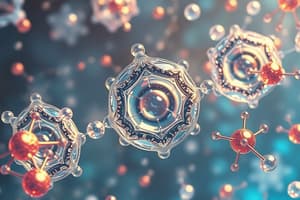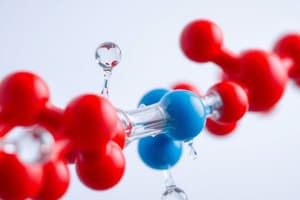Podcast
Questions and Answers
What is the defining characteristic of matter?
What is the defining characteristic of matter?
- Matter has mass and occupies space. (correct)
- Matter has no mass and does not occupy space.
- Matter can be broken down into smaller substances.
- Matter consists only of solid substances.
Which subatomic particles are located in the nucleus of an atom?
Which subatomic particles are located in the nucleus of an atom?
- Protons and electrons
- Protons and neutrons (correct)
- Neutrons and electrons
- Electrons and positions
What is the atomic number of an element?
What is the atomic number of an element?
- The number of protons in the nucleus (correct)
- The number of neutrons in the nucleus
- The number of electrons in a neutral atom
- The total number of subatomic particles in the atom
How does an ion differ from a neutral atom?
How does an ion differ from a neutral atom?
What does atomic mass refer to?
What does atomic mass refer to?
What type of charge does a cation carry?
What type of charge does a cation carry?
What distinguishes an element from other substances?
What distinguishes an element from other substances?
How is weight different from mass?
How is weight different from mass?
What distinguishes isotopes of the same element from one another?
What distinguishes isotopes of the same element from one another?
What term describes the time it takes for half of a sample of radioactive isotopes to decay?
What term describes the time it takes for half of a sample of radioactive isotopes to decay?
In the Bohr model, how are electrons represented?
In the Bohr model, how are electrons represented?
What describes the potential energy of electrons in relation to their position?
What describes the potential energy of electrons in relation to their position?
What is the difference between energy levels and orbitals?
What is the difference between energy levels and orbitals?
What is oxidation in the context of redox reactions?
What is oxidation in the context of redox reactions?
What does the octet rule suggest about atoms?
What does the octet rule suggest about atoms?
Which of the following elements makes up the largest percentage of human body weight?
Which of the following elements makes up the largest percentage of human body weight?
Which statement regarding valence electrons is true?
Which statement regarding valence electrons is true?
How are elements in the periodic table primarily arranged?
How are elements in the periodic table primarily arranged?
What defines the formation of ionic bonds?
What defines the formation of ionic bonds?
What is the characteristic of covalent bonds?
What is the characteristic of covalent bonds?
What distinguishes polar covalent bonds from nonpolar covalent bonds?
What distinguishes polar covalent bonds from nonpolar covalent bonds?
What type of bond is primarily responsible for water's high surface tension?
What type of bond is primarily responsible for water's high surface tension?
Which of the following factors does NOT influence the extent of a chemical reaction?
Which of the following factors does NOT influence the extent of a chemical reaction?
What is the main reason for water's ability to act as a solvent for many substances?
What is the main reason for water's ability to act as a solvent for many substances?
What is the term for the weak and non-directional attractive forces between atoms that are very close to one another?
What is the term for the weak and non-directional attractive forces between atoms that are very close to one another?
Which property allows water to exhibit cohesion?
Which property allows water to exhibit cohesion?
What type of reaction involves a shift of atoms from one molecule to another without a change in their identity?
What type of reaction involves a shift of atoms from one molecule to another without a change in their identity?
What role does electronegativity play in bond formation?
What role does electronegativity play in bond formation?
What is the significance of hydrogen bonding in water?
What is the significance of hydrogen bonding in water?
What occurs when a water molecule exhibits adhesion?
What occurs when a water molecule exhibits adhesion?
What happens to the charge distribution in a water molecule?
What happens to the charge distribution in a water molecule?
Which process involves the breaking and forming of chemical bonds?
Which process involves the breaking and forming of chemical bonds?
What is the effect of water's high specific heat on organisms?
What is the effect of water's high specific heat on organisms?
What happens during the evaporation of water?
What happens during the evaporation of water?
Why does ice float on water?
Why does ice float on water?
What property of water allows it to dissolve polar molecules and ions effectively?
What property of water allows it to dissolve polar molecules and ions effectively?
What occurs when an acid dissociates in water?
What occurs when an acid dissociates in water?
What is the role of buffers in biological systems?
What is the role of buffers in biological systems?
What defines a substance as being neutral in terms of pH?
What defines a substance as being neutral in terms of pH?
How do biological membranes utilize the unique properties of water?
How do biological membranes utilize the unique properties of water?
What characteristic of water contributes to its ability to stabilize temperature changes in the environment?
What characteristic of water contributes to its ability to stabilize temperature changes in the environment?
How do hydrophobic compounds behave in water?
How do hydrophobic compounds behave in water?
Flashcards are hidden until you start studying
Study Notes
Matter and Atoms
- Matter has mass and occupies space, composed entirely of atoms.
- Atoms consist of protons, neutrons (both in the nucleus), and electrons (in orbitals).
Atomic Structure
- Protons are positively charged; neutrons are neutral; electrons have a negative charge.
- The atomic number indicates the number of protons, which equals the number of electrons in a neutral atom.
- Elements cannot be broken down by ordinary means; each has a unique atomic number.
Atomic Mass and Isotopes
- Atomic mass is the sum of protons and neutrons; each has a mass of approximately 1 Dalton.
- Isotopes differ in neutron number but maintain the same atomic number.
- Radioactive isotopes decay over time (e.g., Carbon-14 has a half-life of 5730 years).
Electron Arrangement
- Electron arrangement determines chemical behavior; electrons occupy orbitals around the nucleus.
- Electrons farther from the nucleus possess higher potential energy.
- Energy levels represent energy, while orbitals indicate the electron's probable location.
Chemical Bonds
- Molecules consist of atoms bonded together; compounds contain different types of elements.
- Ionic bonds form through the attraction between opposite charges (cations and anions).
- Covalent bonds involve the sharing of electrons, satisfying the octet rule.
Electronegativity
- Electronegativity is the affinity of an atom for electrons, leading to polar (unequal sharing) or nonpolar (equal sharing) covalent bonds.
- Hydrogen bonds occur between polar molecules due to the attraction of electronegative atoms (e.g., oxygen).
Properties of Water
- Water is crucial for life, with unique properties stemming from hydrogen bonding.
- Cohesion and adhesion due to hydrogen bonds affect water movement in plants and organisms.
- Water has a high specific heat and heat of vaporization, regulating temperature changes in environments.
- Ice is less dense than liquid water, allowing aquatic life to survive under frozen surfaces.
Chemical Reactions
- Involve the formation or breaking of chemical bonds, with reactants transforming into products.
- Influenced by temperature, concentration, and catalysts; many reactions are reversible.
pH, Acids, and Bases
- Water is neutral; pH measures hydrogen ion concentration.
- Acids increase hydrogen ion concentration (lowering pH); bases combine with hydrogen ions (raising pH).
- Buffers resist pH changes, maintaining homeostasis in biological systems.
Biological Buffers
- Typically consist of an acid-base pair, contributing to the stability of pH in living organisms and biochemical processes.
Studying That Suits You
Use AI to generate personalized quizzes and flashcards to suit your learning preferences.




